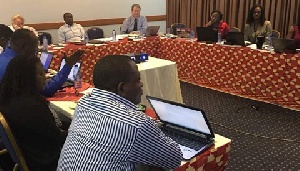 ACET believes financial inclusion would help African countries solve economic growth problem
ACET believes financial inclusion would help African countries solve economic growth problem
People who have no access to bank accounts or other financial services – typically women and the youth – are unable to send and receive payments or store money. This puts a brake on their contribution to economic growth.
On the other hand, when these excluded groups, particularly unbanked women gain access to affordable financial products and services allowing them to transact business and accumulate savings, it stimulates the creation of jobs, benefiting the wider economy.
“Analytical work has shown that when you include women in the economy and improve their access to financial services, this increases GDP by 2 to 3 percent,” says the African Centre for Economic Transformation’s (ACET) Director of Country Engagements and Operations, Dr. Edward K. Brown.
“It is vital for a country’s economic transformation that women and youth are given access to financial services that’ll increase their capacity to contribute to the economy,” Dr Brown adds.
Not only that, but greater financial inclusion would also help African countries solve the structural problem of economic growth that fails to produce jobs for the youth, known as ‘jobless growth’, ACET believes.
Financial inclusion is one of five thematic chapters currently being developed by ACET under the Pan-African Coalition for Transformation (PACT), which was launched in Kigali, Rwanda, two years ago.
To inform the work of PACT, ACET is conducting a comparative study of financial inclusion in Guinea, Sierra Leone and Zambia, supported by Canada’s International Development Research Centre. The study focuses on promoting women’s and youth financial inclusion for entrepreneurship and job creation.
The study will take stock of policy and regulatory interventions, alongside supply side and demand side barriers and innovations, in order to evaluate the success of existing financial inclusion initiatives.
While public policy initiatives may determine progress in accessing financial services on the regulatory side, innovative processes and products can tell us what is being done to broaden financial inclusion beyond traditional male clients on the supply side.
On the demand side, the study will look at how women and youth fare in terms of access, quality, usage and welfare.
A robust methodology is the key to robust results, so to safeguard its reputation as a leading African think tank producing rigorous multi-country studies, ACET experts and facilitators were locked in a two-day inception workshop with researchers to harmonise approaches before going to the field.
The March 12-13 inception meeting discussed the types of questions to ask financial service providers, including mobile phone vendors, and thrashed out issues to do with the selection of sampling sites in the three countries; for example, are shopping malls a good place for interviews on inclusion?
Zambia, with the highest financial inclusion of the three countries will survey 450 respondents and also conduct focus group interviews. Guinea and Sierra Leone have greater levels of economic fragility that will inform their survey design.
But the first problem to be decided is who qualifies to be counted as a youth. Not a totally obvious question because the African Union defines youth as 15-35 years of age, whereas the International Labour Organisation says 15-24 years.
Another big question is culture. Do cultural norms affect women’s financial inclusion? Is this relevant to the ACET study? When ACET tweeted out these questions, one Twitter user suggested this could make for an “insightful analysis of the barriers and possible answers.”
And from a new institutionalist perspective, to the extent that culture provides clues to the informal codes of behaviour that constrain human interaction, it does seem important to test its influence on the financial inclusion activities of significantly more than half the population that are women and youth.
Moving beyond such challenging questions to gather evidence and analyse trends are the first steps in ACET’s policy engagement model for engaging key stakeholders and influencing policies that can catalyse economic transformation across Africa.